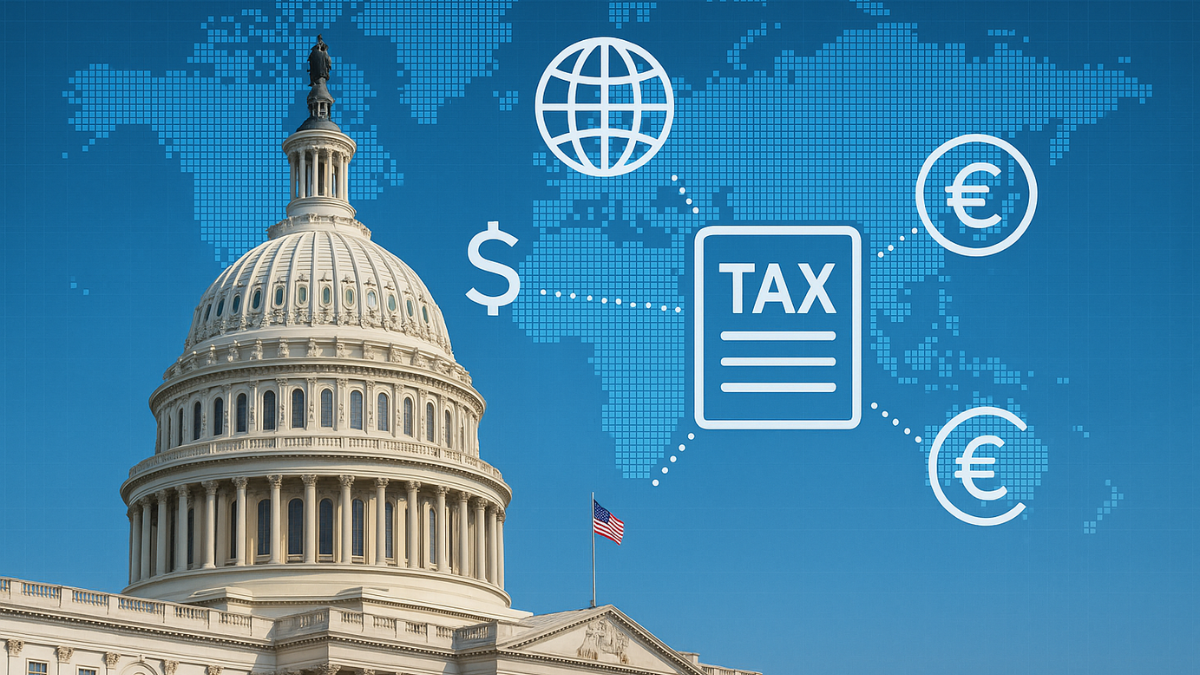The Trade And Tax Issues Behind U.S. - Canada Digital Tax Clash

Since the new Canadian digital services tax went into effect on June 28, many U.S. companies have been pondering how it will affect their e-commerce businesses — and what chunk of their budget this foreign tax burden will consume.
The Canadian digital services tax, or CDST, passed despite U.S. objections. And, on Aug. 30, the Office of the U.S. Trade Representative announced it had requested dispute resolution discussions with Canada under the United States-Mexico Canada Agreement, or USMCA — this despite that corporate income tax issues are at the center of the dispute.[1]
The CDST controversy represents an unusual mix of trade and tax policy, but continues a trend in the U.S. of pursuing trade remedies against countries that unilaterally enact a digital services tax prior to the completion of the Organization for Economic Cooperation and Development’s Pillar One negotiations.[2]
Pillar One is an initiative launched in 2015 by the OECD to expand the authority of countries to tax profits from companies that make sales to customers within their borders, but that lack a physical presence or location in that country.
The U.S. position characterizes digital services tax laws, including Canada’s, as discriminatory because they single out U.S. companies for taxation while effectively excluding foreign firms engaged in similar lines of e-commerce.
The New CDST and the U.S. Reaction
Canada’s Digital Services Tax imposes a 3% tax on revenues earned by domestic and foreign providers from customers located in Canada relating to online marketplaces, online targeted advertising, social media platforms and user data.
Unusually, the law was made retroactive to cover revenues earned in calendar years beginning Jan. 1, 2022. The new law applies to both Canadian and non-Canadian businesses with annual global revenues of €750 million ($837.3 million) or more, and Canadian digital services revenue of more than CA$20 million ($14.8 million).
When the CDST was first proposed in 2022, it came as no surprise that the Office of the U.S. Trade Representative filed comments with the Canadian government raising serious concerns about the plan. In essence, the USTR urged Canada to abandon its proposed digital services tax, and instead redouble its commitment to the rapid implementation of Pillar One and the negotiation of a multilateral convention on this issue.
The USTR specifically noted:
[The] Canadian DST proposal will duplicate most aspects of the DSTs adopted in France, Italy, Spain, Turkey, and the United Kingdom. The United States found these DSTs (and others) to be actionable under Section 301 of the United States Trade Act of 1974 and concluded that these DSTs are discriminatory and burden U.S. commerce. Any tax adopted by Canada would be assessed against the same standard.[3]
Further objections from Congress followed. Senate Finance Committee Chair Ron Wyden, DOre., and ranking member Sen. Mike Crapo, R-Idaho, issued a letter on Oct. 10, 2023, urging the USTR to make clear that the U.S. will “forcefully defend American employers against discriminatory taxes being proposed by Canada.”[4]
The statement noted that the proposed tax would be levied almost exclusively on American companies, and that the retroactive nature of the DST was especially punitive.
In closing, the letter noted: “[we] want the strong economic relationship between the United States and Canada to continue growing. That will become immensely challenging, however, if Canada subjects innovative American companies to arbitrary discrimination without facing any consequences.”[5]
More recently, after the CDST went into effect, every Republican member of the House Ways and Means Committee signed a July 11 letter to the USTR, citing the CDST as discriminatory, and urging the administration to initiate an investigation under Section 301 of the Trade Act.[6]
The letter also requested that the USTR exercise due recourse under the USMCA.
The office of the USTR acted on this recommendation with a request for dispute resolution settlement negotiations, stating in an Aug. 30 announcement that “Canada’s DST appears to be inconsistent with Canada’s commitments under the Cross-Border Trade in Services and Investment chapters of the USMCA not to treat U.S. businesses less favorably than Canadian businesses.”[7]
While this action represents a new wrinkle in the U.S.-Canada trade relationship, it is by no means without precedent. A brief overview of this relationship shows why.
A Long-Standing Trade Relationship
From a geopolitical standpoint, few countries can match the enduring success, prosperity and stability of the relationship between the U.S. and Canada. With a shared history and common values — not to mention a shared 5,525-mile border — the U.S. and Canada have long collaborated militarily and commercially.
In the international trade arena, the U.S. and Canada have negotiated many agreements, starting with the 1814 Treaty of Ghent, which lifted trade restrictions between the two countries and established clear geographic borders.
Over time, as cross-border trade began to ramp up globally, the U.S. and Canada focused on trade agreements to increase commercial activity between the two countries. A bilateral fisheries treaty in 1923 started the trend.
The U.S.-Canada Free Trade Agreement passed both countries’ legislative bodies in 1989, and was expanded five years later by adding Mexico to the North American Free Trade Agreement.[8] In 2020, this trilateral agreement was replaced by the USMCA.
In 2023, Canada was the top U.S. partner for trade in goods and services.[9] With notable integration between the automotive and energy sectors, the close commercial and trade relationships between the U.S. and Canada are undeniable.
Despite this success, international trade issues frequently become high-profile, and they highlight current substantive policy differences between the two countries in this trade- and tax-driven regulatory area.
For instance, the long-running softwood lumber dispute, which began in 1933, turned into a full-fledged trade war in 1982, ultimately leading to a 1986 U.S. Department of Commerce ruling that imports of softwood lumber received subsidies from the Canadian government that were causing material injury to U.S. producers of softwood lumber.
As a result, Commerce imposed steep countervailing duties on all Canadian imports of softwood lumber. Decades of countervailing duties litigation in U.S. courts ensued. Commerce added antidumping duties in 2018 due to unfair price discrimination that was similarly causing material injury to U.S. producers. These added antidumping duties are still in effect.
In addition, Canada challenged U.S. countervailing duties/antidumping duties at the Appellate Body of the World Trade Organization. A final decision in 2004 ruled largely in favor of Canada.
Four rounds of bilateral softwood lumber agreements between the U.S. and Canada were also negotiated, with the last one having expired in 2015. This protracted dispute continues — a binational USMCA panel is currently considering Canada’s new challenges to U.S. countervailing duties.[10]
Finally, and like many countries — including the U.S. — Canada is protective of its dairy and poultry sectors and thus regulates production, sets prices and limits imports.
However, as part of its USMCA obligations, Canada committed to provide greater access to its markets for U.S. producers via a mechanism called tariff-rate quotas.
But two challenges have been brought before a USMCA binational panel since 2020 because the USTR did not agree with the manner in which the tariff-rate quotas were being applied and administered by Canada. One decision in 2021 was in favor of the U.S.; the other in 2023 ruled in favor of Canada.
Tax and Trade Intertwined
The new Canadian tax is not just a corporate income tax enacted under the global auspices of the OECD. It is also a trade issue under the auspices of the WTO. Among other issues, whether to overturn the WTO moratorium on collecting customs duties for e-commerce transactions has been on the agenda of every annual ministerial meeting of the WTO since 1998.
In fact, a working group of 91 WTO members recently issued a stabilized text — a document that could serve as the basis for any future comprehensive WTO agreement on electronic commerce concerning digital trade and customs duties. No specific language ending the moratorium on customs duties was included, but the moratorium was extended until March 31, 2026.
The U.S. did not support the stabilized text, but the European Union and China did. India, South Africa and Indonesia were strongly opposed to any extension of the moratorium.
Thus, it is expected that this issue will continue to challenge the WTO’s ability to reach consensus among all 164 member states on significant global trade policy matters, especially with the U.S., without whose support no final agreement can ever be reached — just as with Pillar One. The outcome of the Pillar One proposals may also have a direct effect on the WTO’s treatment of e-commerce for duty purposes.
U.S. Section 301 Investigations
U.S. opposition to CDST and DSTs in general is legally grounded in Section 301 of the Trade Act of 1974, which allows the U.S. to impose trade sanctions on countries that violate trade agreements or engage in practices that burden U.S. commerce. These sanctions usually take the form of additional customs duties imposed on targeted imported merchandise from the offending country.
The most prominent example of the use of Section 301 concerns China. Trade remedy tariffs of 25% or 7.5%, determined by tariff code, under this statute were imposed on most Chinese-originating merchandise, also determined by tariff code, beginning in 2018 during the Trump administration.
After the conclusion of a “sunset” review on May 13,[11] the Biden administration concluded that grounds still existed for keeping the Section 301 tariffs in place because China had not demonstrated any progress in eliminating the practices that burdened U.S. commerce. In addition, increasing those tariffs up to 100% on certain categories of merchandise was proposed as part of the sunset review.
A final decision on the tariff increases was announced on Sept. 13, confirming the increase to 100% on merchandise classified under certain tariff codes.[12]
As Pillar One proposals were put forth by the OECD and various countries began the process of drafting legislation to impose unilateral DSTs, USTR promptly launched Section 301 investigations of those countries in 2019-2021. Countries under investigation included Austria, Brazil, Czech Republic, France, India, Indonesia, Italy, Spain, Turkey and the U.K.
Most of these investigations were terminated because the countries at issue had not yet adopted or implemented a DST regime, thereby precluding USTR from completing an investigation within the one-year statutory deadline from the date of initiation.[13] In each instance of termination, USTR specifically noted that “[it] will continue to monitor the status of any proposed or adopted DST in these … jurisdictions and may, if appropriate, initiate one or more new Section 301 investigations.”[14]
Conclusion
Given that this is an election year and that a new administration — and new USTR — will take office in January 2025, an issue of this magnitude will not be resolved before the end of the year.
The larger issue of the American technology industry’s global dominance, and how it can be fairly taxed in all the jurisdictions where it does business, is something that the OECD is supposed to be resolving via the OECD’s Pillar One proposals.
Perhaps Canada will follow India’s lead and simply repeal the CDST until such time as the OECD finally concludes the Pillar One negotiations with a clear set of rules for global e- commerce.
At the same time, other OECD members should refocus their efforts on finalizing the rules around e-commerce so that a clear road map can be in place for all governments worldwide — not just the U.S. — acceding to power in 2025.
Even with these efforts, the USTR’s call for a dispute settlement dialogue with Canada could ultimately require a binational panel, similar to the panels convened to address the softwood lumber and dairy quota issues.
However, the CDST is not purely a trade issue in that it involves the corporate income tax treatment of global revenue earned from e-commerce. Few panelists drawn from rosters of government-appointed trade lawyers are likely to have the technical qualifications to rule on this kind of a hybrid dispute.
Consequently, Canada may be targeted by a new Section 301 investigation, investigations in which the U.S. has a proven track record of achieving at least partially positive results when challenging foreign countries’ unilateral enactment of DSTs. Either way, this latest tension in U.S.-Canada trade relations will no doubt continue in 2025 and beyond.
Written by Damon V. Pike. Copyright © 2024 BDO USA, P.C. All rights reserved. www.bdo.com
The opinions expressed are those of the author(s) and do not necessarily reflect the views of their employer, its clients, or Portfolio Media Inc., or any of its or their respective affiliates. This article is for general information purposes and is not intended to be and should not be taken as legal advice.
___________________________________________________________________________________________________________________
[1] Taxes cover not just direct corporate taxes, but also indirect taxes like customs duties and Goods and Services Taxes in Canada (Canada’s version of a VAT). Digital services taxes, however, are squarely within the realm of corporate income taxes. Nonetheless, as discussed herein, the U.S. uses customs duties as a trade remedy to combat what it deems laws or actions by foreign countries that unfairly burden U.S. commerce, such as the CDST.
[2] Work continues at the international level on the development and refinement of the Pillar One proposals, but no final agreement has been reached.
[3] https://ustr.gov/sites/default/files/USTR%20Cmts%20on%20Canadian%20DST%20Proposal.2022.02.22.pdf.
[4] https://www.finance.senate.gov/chairmans-news/bipartisan-finance-committee-leaders-ustr-must-tell-canada-the-us-will-fight-discriminatory-digital-services-taxes-on-american-companies.
[5] https://www.finance.senate.gov/imo/media/doc/20231010wydencrapolettertoustroncanadadst.pdf.
[6] https://waysandmeans.house.gov/wp-content/uploads/2024/07/7.11.24-Canada-DST-Letter-to-Ambassador-Tai.pdf.
[7] See: https://ustr.gov/about-us/policy-offices/press-office/press-releases/2024/august/united-states-requests-usmca-dispute-settlement-consultations-canadas-digital-services-tax.
[8] NAFTA expanded rules from the 1989 agreement to provide new rules of origin by which goods could qualify for duty-free entry into the three members states using concepts of regional value content calculations and “tariff shift” rules involving tariff codes for raw materials and finished goods. These rules have been used in every subsequent U.S. free trade agreement.
[9] Although Mexico imports more from the U.S. than does Canada, this is offset by Canada receiving more U.S. exports than Mexico, https://crsreports.congress.gov/product/pdf/IF/IF12595#.
[10] These panels were first devised as part of NAFTA and were intended to replace judicial review in the courts of the signatory countries.
[11] 89 Fed. Reg. 76851 (Sept. 18, 2024).
[12] Under the applicable statute, USTR is required to launch a review of whether Section 301 duties are still needed to combat the unfair foreign trade practice upon the four-year anniversary of the imposition of those duties. The statute does not impose a mandatory timetable for concluding that review; the recent sunset review began in late 2022 and concluded in May 2024.
[13] After settling its Section 301 investigation with USTR in 2021, India recently voluntarily repealed its version of a DST (the “Equalization Levy”) to take effect on August 1, 2024.
[14] 86 Fed. Reg. 16829 (March 31, 2021).
 Services
Services

